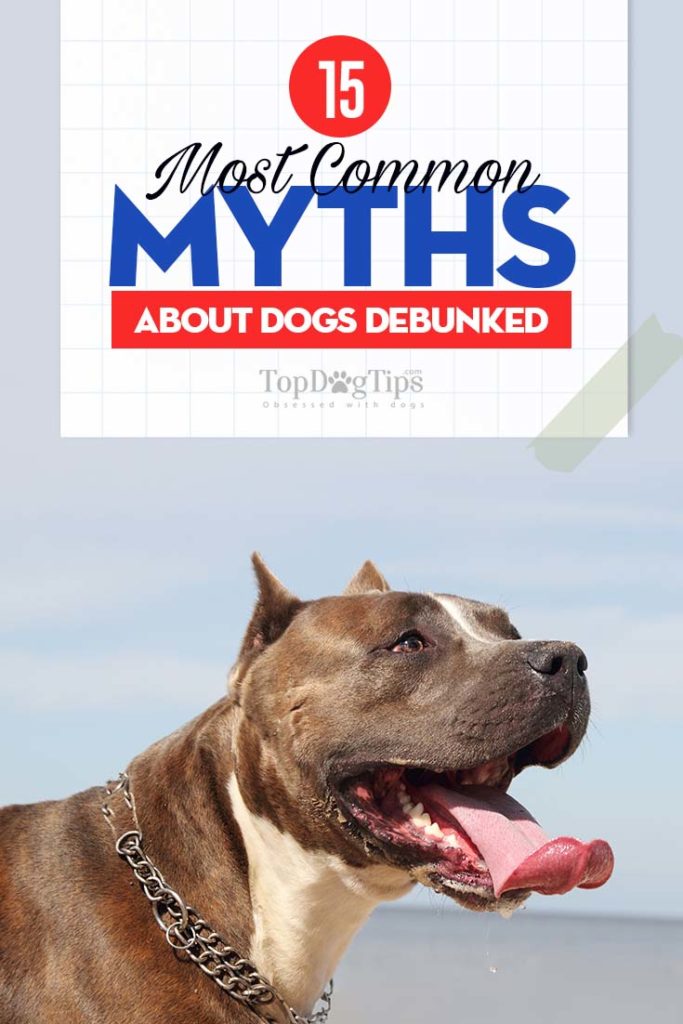There are many fascinating dog myths and facts out there – some true, some false. These myths have been passed down by generations of dog owners, but some of them must be debunked for the health and safety of dogs and their owners.
1. “My Dog Is More Dominant/Submissive Than Yours”
Table of Contents
- 1. “My Dog Is More Dominant/Submissive Than Yours”
- 2. “Dogs Wag Their Tails When They’re Happy”
- 3. “Dog's Dry Nose Means They're Sick”
- 4. “Dogs Heal Themselves by Licking Wounds”
- 5. “Dogs Eat Grass When They're Sick”
- 6. “Big Dogs Can’t Live in Apartments”
- 7. “Dogs are Color Blind”
- 8. “All Large Dogs Make Good Guard Dogs”
- 9. “You Can’t Teach an Old Dog New Tricks”
- 10. “One Year of a Dog’s Life is Equal to 7 Human Years”
- 11. “Same Breed Means Same Personality”
- 12. “Well Trained Dogs Would Never Bite Anyone”
- 13. “Female Dogs Need to Have a Litter of Puppies”
- 14. “Dogs in Cars are Fine with Windows Slightly Open”
- 15. “All Dogs Hate Mail Carriers”
You may have heard this from owners when introducing your dog to their pups. Maybe you've noticed that sometimes your dog accepts another dog’s posturing and submits to being lower in that social dynamic, but other times he decides to be in charge.
The idea of dominant vs submissive behavior in dogs can be confusing because trainers have several theories. However, studies from behaviorists and scientists agree on one aspect: these traits are specific to a current environment or situation.
For example, just as our behavior changes depending on who is in the room with us (you defer to your boss or parent, while directing your employees or children), it's similar in dogs’ social hierarchy. A dog may have the tendency to be dominant or submissive, but if he’s assessed through posturing that he can’t win, he’ll submit to avoid further conflict.
2. “Dogs Wag Their Tails When They’re Happy”
Dogs communicate both vocally and through body language, and this includes the signals they send out with their tails. The image of a dog wagging a tail is associated with happiness, but it’s a common dog myth all wagging tails are always positive in nature.
Scientists have been studying dog body language for decades, and have figured out some aspects of canine behavior that do not necessarily agree with the common knowledge of pet owners. When it comes to tail wags, depending on the tail position and wagging speed, dogs can display different emotions that reflect the current situation.
For example, a slight and slow wag can be for “considering an initial greeting,” and based on the response from the other dog, it can quickly change to a broader “let’s be friends” wag, slow down to a high-held tail with almost no wag “I am challenging you” or down to between the legs with a quick wag “I submit, we’re cool”.
3. “Dog's Dry Nose Means They're Sick”
Although there are times where one of the symptoms of illness can include a dry nose (if the dog has a fever or is dehydrated), it does not mean that your dog is automatically sick every time their nose is dry.
A dog's nose naturally gets dry, such as when they're sleeping. Thus, an older dog who sleeps a lot will consistently have a dryer nose than puppies. It’s also possible the dog has allergies or has been out in the sun and got sunburned.
4. “Dogs Heal Themselves by Licking Wounds”
It's not a dog myth because saliva of dogs does indeed contain a small amount of antibacterial properties (but so does human saliva!) Nevertheless, this escalated dog myths among owners that it’s beneficial to let their pets lick wounds or incision areas.
Human saliva has been studied for decades to find out how to extract those compounds for the healing of other health issues in people. However, there are two ways to look at it: both human and dog saliva also contain some bacteria which poses a risk of infection.
Furthermore, while a small amount of dog licking isn’t necessarily harmful, the problem with continued licking of wounds is that can further damage the area by inhibiting healing cells from forming properly.
Wound healing cells create a scab that allows new skin cells to form and heal the wound, but they can only form if the wound is both clean and dry. Constant licking creates a moist environment and also makes wounds susceptible to bacterial complications.
5. “Dogs Eat Grass When They're Sick”
It’s true that dogs have a tendency to eat grass and then vomit, and it’s been theorized that they do this because their stomach is upset. However, research shows that only a small percentage will vomit after eating grass. Some dogs simply love the taste of grass, especially new spring growth, and will graze like cows if allowed.
Your dog might also be prone to a condition called Pica, where the dog might eat things like stones and soil. This can be caused by a nutritional deficiency, stomach sensitivities or boredom. If it's the latter, or your dog constantly eats grass to vomit, it’s worth getting a check up at the vet to assess for any digestive issues or underlying illness.
6. “Big Dogs Can’t Live in Apartments”
When you adopt any dog, you have to consider the type of environment or housing you can provide for them. Some large breed dogs are very active, clumsy and drool a lot, which does not mesh well with a small apartment living where he could cause damage.
But the assumption that the larger the breed, the worse it will be for the dog to live in an apartment is incorrect. Whether the dog is a good fit for apartment living depends on the dog's physical and mental stimulation requirements. Some medium dogs cannot live in apartments while plenty of large breeds are perfectly fine in apartments and condos.
In general, a large number of big breeds do very well living in a small space as long as they get enough exercise during the day. Their general size is rarely the problem.
7. “Dogs are Color Blind”
There’s some speculation about a dog’s ability to see colors, be it specific hues or a color spectrum. A well known dog fancier in the 1930’s, Will Judy (who also founded National Dog Week) first remarked that dogs only see in “varying highlights of black and grey”.
This hypothesis was widely accepted in the beginning with no research being done until the last few decades when scientists really began to examine the eye structures of different animals, including the dog. It’s since been proven in studies that dogs can see specific spectrum of color, and they do not see in black and white.
8. “All Large Dogs Make Good Guard Dogs”
Most dog breeds can fulfill the “watch dog” role in a family: warning about strangers or some threat. But guard dog depends on on the dog's personality than their size. Plus, in most cases, the dog also needs to be trained to warn and protect, and not all large breeds are suitable for this type of training.
A large dog is certainly more threatening and produces a more intense bark, but it takes more than those traits to be considered an effective watch dog. The combination of skills and innate ability that marks a breed capable of this job are specific, and includes dogs of all sizes and many breeds.
Large dogs with dominant chase/prey aggression instinct aren’t suitable for guarding because it’s more difficult to for them to learn both recall and bite inhibition. If you’re considering training your dog in professional guarding skills, employ an experienced guarding trainer that uses safe and non-abusive techniques to train guard dogs.
9. “You Can’t Teach an Old Dog New Tricks”
This proverbial saying has surprisingly been around since the 1500’s, and perpetuated ever since, being used not only in actual context relating to dogs but also when describing each others’ habits.
Although a catchy phrase, it’s one of those dog myths that's not entirely true. While old dogs are harder to train, they certainly can be trained. With senior dogs, you will simply need to take other factors into consideration, such as less energy, overall physical condition and possible mental health issues.
10. “One Year of a Dog’s Life is Equal to 7 Human Years”
Dogs age quicker compared to humans; however, new studies show that this dog myth is definitely untrue. Moreover, the aging process is different between breeds, especially related to size, and cannot be generalized as a 1:7 ratio. Small breeds of dogs usually live longer than large breeds, with their average lifespans being around 14 yrs vs 9 yrs.
Toy dog breeds like Chihuahuas and Pomeranians are slower and can live longer – some are known to live as long as 18-20 years. Giant breeds like Great Danes and Irish Wolfhounds age much quicker and have a life expectancy of 6-8 years.
11. “Same Breed Means Same Personality”
The combination of nature and nurture is essential for the development of behavior, personality and survival of all species. In dogs, a majority of their personality traits do come from genetics. This includes loyalty, temperament, and excitability.
This is why testing dog's genetics with dog DNA tests has become so popular: pet owners want to know what type of dog they've adopted. But what remains ignored is that the way dogs are raised from puppy-hood will also help to shape a dog's individual personality, as all dogs are unique, just like people.
The genetics of personality traits and how they are affected by breeding is especially relevant to new “designer breeds”, as their genetic personalities can be unpredictable with each new generation. Studies also explained how this impacts why some dogs are more independent than others.
12. “Well Trained Dogs Would Never Bite Anyone”
A common situation for people is going to pet a strange dog and looking at the owner for permission, and the owner says: “oh don’t worry, my dog never bites”. Although it may be the case that the dog has never bitten anyone before, it’s impossible to say that a dog would never bite.
Aggression in dogs has been extensively studied and it's a complex issue caused by a large number of factors. There are a few scenarios that would cause even the best trained dog to react in this way. For example, dogs in fear or in pain are unpredictable and may bite or lash out even to those trying to help them.
13. “Female Dogs Need to Have a Litter of Puppies”
Unfortunately, this dog myth has led to many unwanted and abandoned litters of puppies, and dogs that ended up in shelters. Whelping can be a difficult process for the dog and owners, so if there's no reason for your female dog to get pregnant, then don't force it.
But this idea is false, and female dogs do not “miss anything in life” by not having the chance to give birth to puppies. Spaying your female dog at the right age, depending on breed and maturity, will not only help control the overpopulation of dogs but also save her from potential diseases like pyometra and cancer of the reproductive system.
14. “Dogs in Cars are Fine with Windows Slightly Open”
Less people are inclined to believe such dog myths anymore, which is good considering the many recent press stories about dogs suffering and even dying of heatstroke because they were left alone in a car during hot days.
Even with a window cracked open, the temperature inside a car can rise dramatically in minutes, leaving all beings (human or animal) in a potentially life-threatening situation like overheating and fatal heatstrokes.
15. “All Dogs Hate Mail Carriers”
Unfortunately, mail carriers have been on the receiving end of dogs’ protective nature since they first started delivering letters to homes, but this is one of those dog myths that's based on anecdotal evidence only.
Most dogs will protect their home and territory from anyone. The reason dogs bark, even if it's been the same mail carrier for years, is a behavioral “cause and effect” scenario that rewards the dog through their action. Intruder comes to the door, dog barks, and intruder leaves.
This consistent action leads your dog to believe that their bark made the mailman leave, so the dog continues to do so daily. He would do the same if you had food delivery or courier service, so it’s not specifically targeted at the post office workers.





















